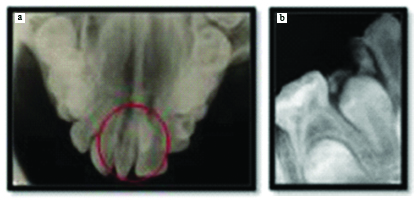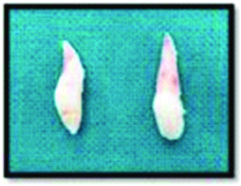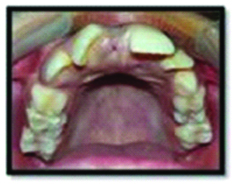“Mesiodentes-A Common Supernumerary in a Unique Appearance”: A Case Report and Literature Review
Suma Sogi1, Deepika Patidar2, Dinesh Chand Patidar3, Priyanka Prasad4
1 Professor and Head, Department of Pediatric and Preventive Dentistry, Maharishi Markandeshwar College of Dental Sciences and Research, Mullana, Ambala, Haryana, India.
2 Senior Lecturer, Department of Pediatric and Preventive Dentistry, Maharishi Markandeshwar College of Dental Sciences and Research, Mullana, Ambala, Haryana, India.
3 Senior Lecturer, Department of Oral and Maxillofacial Surgery, Maharishi Markandeshwar College of Dental Sciences and Research, Mullana, Ambala, Haryana, India.
4 Postgraduate Student, Department of Oral Medicine and Radiology, Karnavati School of Dentistry, Gandhinagar, Gujarat, India.
NAME, ADDRESS, E-MAIL ID OF THE CORRESPONDING AUTHOR: Dr. Deepika Patidar, H-29, Maharishi Markandeshwar (Deemed to be University) Campus, Mullana, Ambala-133207, Haryana, India.
E-mail: drdeeepika.prasad@gmail.com
Mesiodens is the most common form of supernumerary teeth. When mesiodens erupt in multiples, either labial or palatal to permanent central incisor, it presents a rare condition “Mesiodentes”. This case report demonstrates the presence of erupted double mesiodens giving an unaesthetic appearance in a non-syndromic 10-year-old male patient.
Mesiodens,Occlusal radiograph,Supernumerary teeth
Case Report
A 10-year-old healthy male reported with the chief complaint of extra teeth in his upper front region of the jaw since three years. Patient desired for extraction of ‘extra teeth’, due to unaesthetic appearance and poor oral hygiene maintenance. Patient has not taken any previous dental treatment for the same and no significant medical history was found. On examination, patient was found normal without any syndromic characters and a mixed dentition period with the presence of two erupted supernumerary teeth in premaxillary region were noted. Among them one was located between #11 and #21 and other was palatal to #21. Other findings included poor oral hygiene with generalised stains and calculus deposition, Angle’s Class I malocclusion with rotated #11 and #22 and midline diastema, dental caries w.r.t #54, #55 and #85 along with root stump w.r.t #84 [Table/Fig-1 a-c].
a) In occlusion with the presence of mesiodens. b) Maxillary arch showing mesiodentes, one between #11 and #21 and one palatal to #21. c) Mandibular arch showing root stump w.r.t #84.

A maxillary occlusal radiograph on investigation revealed the presence of two erupted supernumerary teeth in maxillary anterior teeth region. Diagnosis of double mesiodens/mesiodentes in the maxillary anterior teeth region was made. Both the mesiodens were of conical variety, vertically oriented and smaller in dimension as compared to the adjacent normal teeth. The mesiodens located between #11 and #21 showed well-formed root, however a shorter root was noticed w.r.t mesiodens palatal to #21 [Table/Fig-2a]. A Radiovisiograph (RVG) w.r.t #84 showed resorbed roots and erupting mandibular right first premolar #44 [Table/Fig-2b].
a) Maxillary occlusal radiograph showing mesiodentes. b) RVG showing root stump w.r.t #84 and erupting #44.

Patient was cooperative with Frankl behaviour rating III scale. Treatment plan was explained to the patient and parents. He underwent an ultrasonic scaling with oral hygiene instructions, glass ionomer cement restoration done w.r.t #54, #55 and #85. On the basis of clinical and radiographic findings, the root stump w.r.t #84 was advised for extraction. Both the mesiodens and root stump w.r.t #84 were extracted (intra-alveolar extraction method) under local anaesthetic infiltration by using 2% lignocaine with adrenaline hydrochloride and post-operative instructions were given [Table/Fig-3]. After one week follow-up, the extraction socket showed satisfactory healing [Table/Fig-4]. Although a fixed orthodontic treatment was advised to the patient for proper alignment of maxillary anterior teeth, patient did not report back for the further treatment procedure.

Intraoral view after one week follow-up.

Discussion
“Supernumerary teeth are those which are in excess of the normal set of dentition” [1]. Their first report emerged between AD 23 and 79 [1] In different population, their prevalence ranged from 0.1-3.6% with males affected more than females (2:1) and among them mesiodens comprise of approximately one third cases [2]. In Indian population, the incidence is 87% with single, 12% with two while 1% with multiple supernumerary teeth. Mesiodens is the most common form of supernumerary tooth [2].
The word mesiodens was given by Balk (1917) to specify a supernumerary tooth present between central incisors in the premaxillary region. It is found more frequently in the permanent teeth (0.1-3.6%) than primary teeth (0.02-1.9%) [1]. They are usually found as singles however, its multiple occurrence is called as “mesiodentes” which could be either labial or palatal to permanent central incisors [3-6]. They are generally small, with conical morphology and a short root, appearing single, double, erupted or even unerupted [2]. The present case reported the presence of mesiodentes in anterior maxillary region and its associated dental abnormalities in a non syndromic 10-year-old child.
Mesiodens accounts for 30% incidence of all supernumerary teeth [6]. Three controversial theories had been proposed concerning the presence of mesiodens. The first is atavistic theory, which suggested that phylogenetic recapitulation of our precursors with three central incisors give rise to mesiodens [7], while according to dichotomy theory; asymmetrical splitting of tooth bud produce two teeth regions which results in mesiodens formation. The third and widely accepted theory put forward the hyperactivity of dental lamina where the remnants of dental lamina are developed into an extra tooth bud [8]. Moreover, the presence of the several foramina and canals in the pre maxillary region along with complex system of joining of numerous bony processes give rise to the developing tooth buds more prone to division in this region [9]. This is in agreement with literature review done by Meighani P where 80-90% of all supernumerary teeth were noticed in the maxilla [10], additionally Von Arx T observed that majority of supernumerary teeth found palatal to the central incisors [11].
The presence of mesiodens in the midline may change the appearance and occlusion by varying the path and position of the eruption of permanent central incisors [3]. The reported case was unique eruption of double mesiodens in a non syndromic healthy 10-year-old male child where one was located between two permanent maxillary central incisors and other was palatal to maxillary left central incisor resulting in an unaesthetic appearance due to midline diastema, rotation of maxillary right permanent central incisor and left lateral incisor and poor oral hygiene. As it is well known fact that mesiodens are twice more common in males than females [2], similarly most of the mesiodens in the case studies listed in [Table/Fig-5] as well as in the present case were found in a male patient. Various case studies have reported the presence of erupted mesiodentes [Table/Fig-5] [2-6,12-20], in contrary Gharote HP et al., and Canoglu E et al., noticed the presence of inverted and unerupted/impacted mesiodens in their studies [5,21]. Almost all the cases of mesiodentes reported in various studies were conical in shape and the present case followed the same pattern. However, Gharote HP et al., and Manne R et al., noted a tuberculate type mesiodens [5,17], while Villavicencio J et al., and Hundal KD et al., observed a molariform variety as well [18,19]. Majority of mesiodentes reported in various studies as well in the present study were two in number, although Gharote HP et al., and Kulkarni VK et al., even found three and four mesiodentes respectively [5,13]. Taking into consideration the patient’s age and complications associated with the mesiodentes (unaesthetic appearance and psycho social problems), extraction was the treatment of choice in this reported case.
A review reporting the presence of erupted mesiodentes with respect to their type, number and location [1-6,12-20].
| Author | Year | Age (Yrs)/Sex | Variety/Type | Number | Location |
|---|
| Marya CM et al., [12] | 1998 | 12/M | Conical | Two | Between #11 and #21 |
| Kulkarni VK et al., [13] | 2010 | 12/M | 1 Conical, 3 Supplemental | Four | Between #12 and #21 |
| Bali N et al., [14] | 2010 | 13/M | Conical | Two | Palatal to #11 and #21 |
| Karthik V et al., [2] | 2011 | 13/M | Conical | Two | Palatal to #11 and #21 |
| Gharote HP et al., [5], out of six reported cases, erupted mesiodentes in three cases. | 2011 | 26/M | Conical, Supplemental | Two | Palatal to #11 and #21 |
| | 12/M | Conical, Tuberculate | Three | One between #11 and #21, one palatal to first mesiodens and one fused to #11. |
| | 24/M | Tuberculate | Two | Palatal to #11 and #21 |
| Reddy M et al., [15] | 2013 | 14/M | Conical | Two | Both labially placed to #11 and #21 |
| Nagrathna C et al., [16] | 2014 | 4/M | Conical | Two | One between #52 and #61 and other palatal to #61 |
| Singaraju GS et al., [6] | 2015 | 23/M | Conical | Two | Between #11 and #21 |
| Asha ML et al., [4] | 2015 | 10/M | Conical | Two | Between #11 and #21 |
| Manne R et al., [17] | 2015 | 25/M | 1 Tuberculate, | Two | Between #11 and #21 |
| | | 1 Conical | | Palatal to first mesiodens. |
| Villavicencio J et al., [18] (Three cases) | 2015 | 11/M | Supplemental | Two | Between #11 and #21 |
| | 10/M | Molariform | Two | Between #12 and #22 |
| | 9/M | Conical | Two | Between #11 and #21 |
| Hundal KD et al., [19] | 2016 | 10/F | 1 Conical, | Two | Palatal to #11 |
| | | 1 Molariform | | Palatal to #21 |
| Sujlana A et al., [20] | 2017 | 8/M | Conical | Two | Between #52 and #62 |
| Krishnamurthy NH et al., [1] | 2017 | 13/M | Conical | Two | Between #11 and #21 |
| Srinivasan S et al., [3] | 2017 | 12/M | Conical | Two | Palatal to #11 and #21 |
Conclusion
This case report demonstrates the presence of mesiodens in a unique multiple appearance as mesiodentes in the pre-maxillary region causing malpositioning of the permanent maxillary incisors and aesthetic concern for the patient. Early diagnosis and timely extraction of the mesiodentes is essential to prevent further malalignment and facilitate early orthodontic intervention of the developing malocclusion which ultimately enhances the quality of life and self-confidence of the patient.
[1]. Krishnamurthy NH, Unnikrishnan S, Thimmegowda U, Thomas J, Fully erupted twin mesiodens: A case report Int J Current Research 2017 9(6):52667-70. [Google Scholar]
[2]. Karthik V, Anantharaj A, Praveen P, Prathibha RS, Jaya AR, Twin mesiodens in the maxillary arch causing difficulty in speech: A case report Int. Dentistry. African Edition 2011 1(2):90-94. [Google Scholar]
[3]. Srinivasan S, Nandlal B, Palatally erupted twin maxillary mesiodens: A case report Int J Adv Res 2017 5(4):440-44.10.21474/IJAR01/3829 [Google Scholar] [CrossRef]
[4]. Asha ML, Laboni G, Rajarathnam BN, Mahesh Kumar HM, Lekshmy J, Priyanka LB, Twin mesiodens: a case report Int J Advanced Health Sciences 2015 2(6):18-21. [Google Scholar]
[5]. Gharote HP, Nair PP, Thomas S, Prasad GR, Singh S, Non syndromic double mesiodentes-hidden lambs among normal flock! BMJ Case Report 2011 1110.1136/bcr.07.2011.44202267873 [Google Scholar] [CrossRef] [PubMed]
[6]. Singaraju GS, Reddy B, Supraja G, Narayana RK, Floral double mesiodentes: A rare case report J Nat Sci Biol Med 2015 6(1):229-31.10.4103/0976-9668.14919725810670 [Google Scholar] [CrossRef] [PubMed]
[7]. Osburn AS, Original communications on supernumerary teeth in manand other mammals Dental Cosmos 1912 54:1192-203. [Google Scholar]
[8]. Black GV, Supernumerary teeth Dental Summit 1909 29:83-110. [Google Scholar]
[9]. Saarenmaa L, The origin of supernumerary teeth Acta Odontol Scand 1951 9:293-303.10.3109/0001635510901279114877538 [Google Scholar] [CrossRef] [PubMed]
[10]. Meighani P, Mesiodens: diagnosis and management of supernumerary (mesiodens): a review of the literature J Dent Tehran Univ Med Sci 2010 7:41-49. [Google Scholar]
[11]. Von Arx T, Anterior maxillary supernumerary teeth: a clinical and radiographic study Aus Dent J 1992 37:189-95.10.1111/j.1834-7819.1992.tb00741.x1627067 [Google Scholar] [CrossRef] [PubMed]
[12]. Marya CM, Kumar BR, Familial occurrence of mesiodentes with unusual findings: case reports Quintessence International 1998 29(1):49-51. [Google Scholar]
[13]. Kulkarni VK, Reddy S, Duddu M, Multidisciplinary management of multiple maxillary anterior supernumerary teeth: A case report Quintessence International 2010 41(3):191-95. [Google Scholar]
[14]. Bali N, Bali S, Twin mesiodens: A case report Health Talk 2010 :7-8. [Google Scholar]
[15]. Reddy GS, Mahajan B, Desai RS, Mesiodens in twins: a case report Indian Journal of Dental Sciences 2013 5(1):088-089. [Google Scholar]
[16]. Nagarathna C, Shakuntala BS, Sneha T, Management of twin mesiodens to create a natural space maintainer Clinical Dentistry 2014 8(4):10-13. [Google Scholar]
[17]. Manne R, Reddy SE, Sameera A, Mir MMA, An unusual case of mesiodentes: peek-a-boo. International Organization of Scientific Research Journal of Dental and Medical Sciences (IOSR-JDMS) 2015 14(5):Ver. III:91-94. [Google Scholar]
[18]. Villavicencio J, Hernández J, Medina S, Clinical variations of double mesiodens: a review and case report Revista Facultad de Odontología Universidad de Antioquia 2015 27(1):216-27. [Google Scholar]
[19]. Hundal K, Kaur RD, Sharma SK, Banik S, Arora KS, Occurrence of double mesiodens and an inverted mesioden: a report of 2 rare cases Journal of Oral Medicine, Oral Surgery, Oral Pathology and Oral Radiology 2016 2(3):187-89.10.5958/2395-6194.2016.00044.8 [Google Scholar] [CrossRef]
[20]. Sujlana A, Pannu P, Bhangu J, Double mesiodens: a review and report of 2 cases General Dentistry 2017 65(5):61-65. [Google Scholar]
[21]. Canoglu E, Nuray Er, Cehreli Z, Double inverted mesiodentes: report of an unusual case European Journal of Dentistry 2009 3:219-23.10.1055/s-0039-169743519756197 [Google Scholar] [CrossRef] [PubMed]